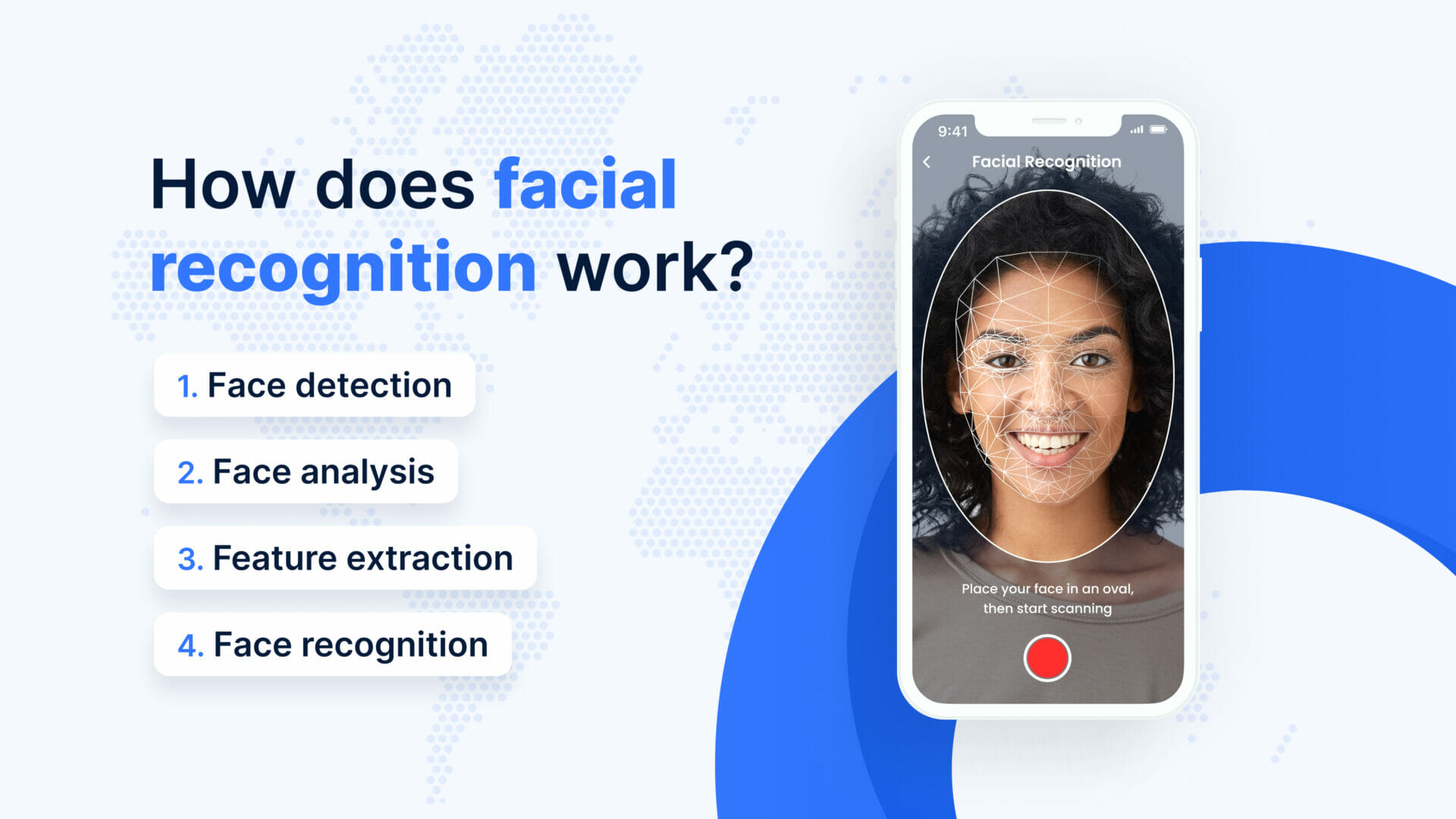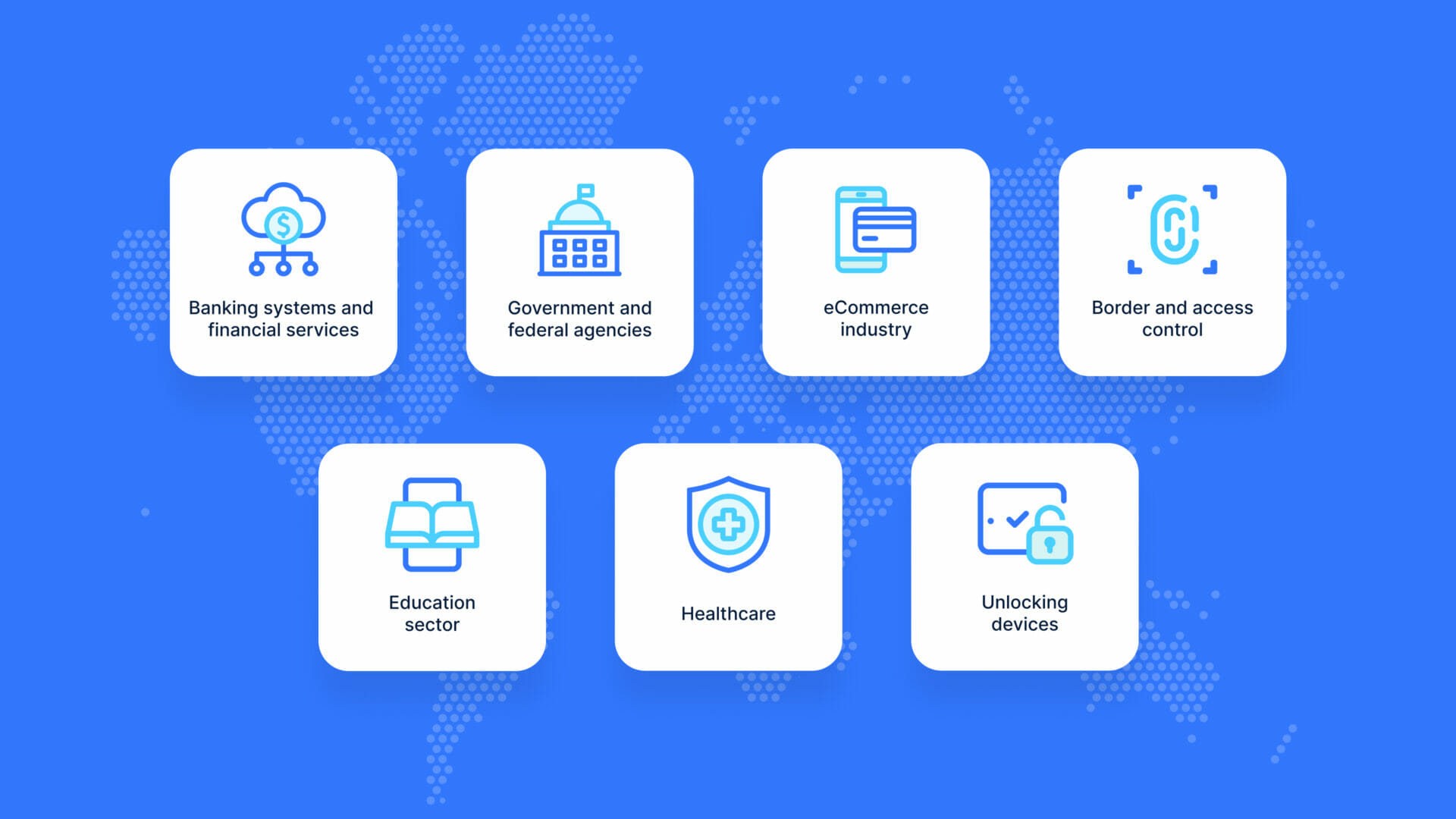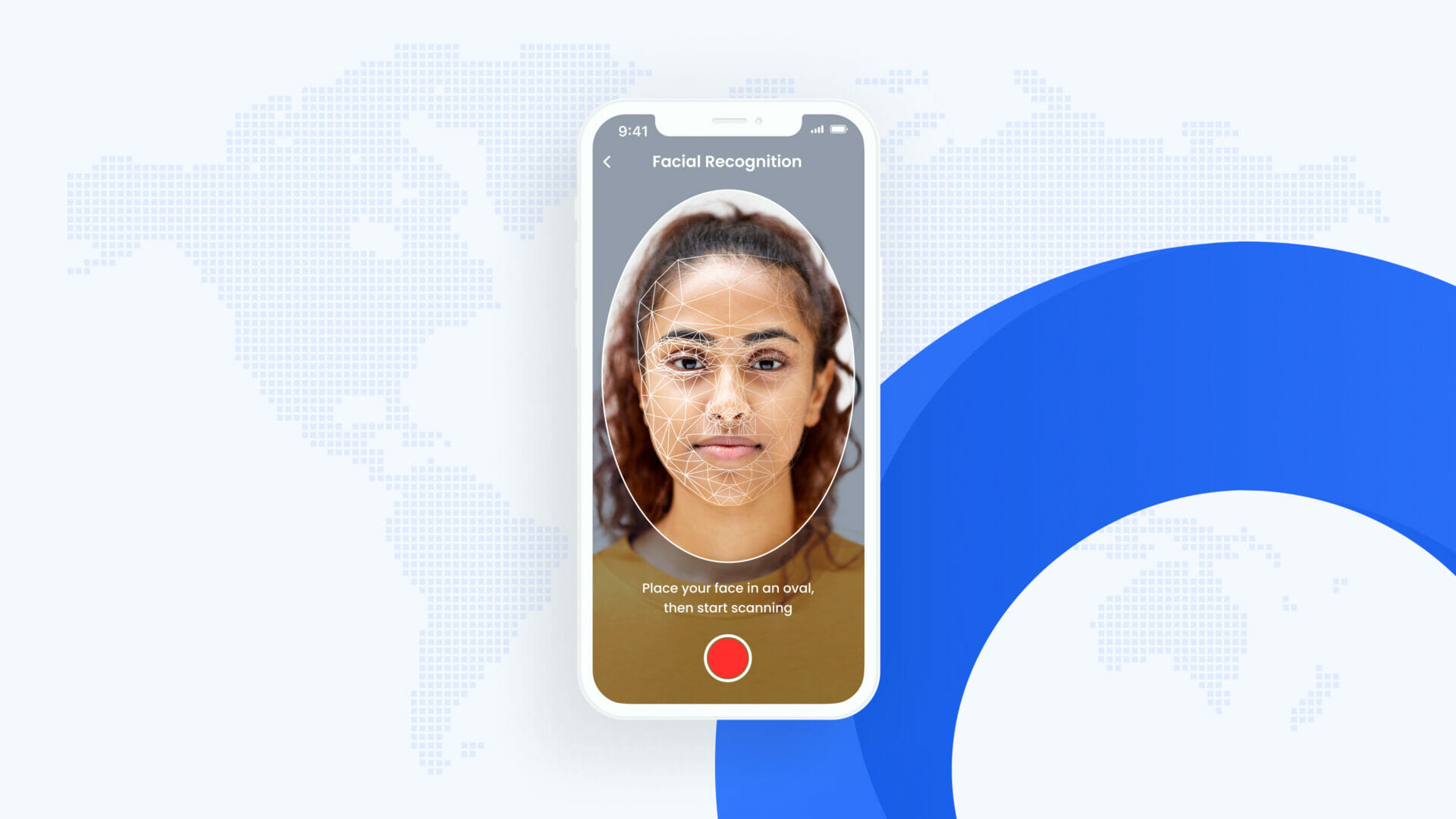Table Of Contents
- What is facial recognition?
- How does facial recognition work?
- Facial Recognition and Facial Authentication, what’s the difference?
- What are the benefits of facial recognition?
- Where is facial recognition used?
- How is facial recognition used in digital identity?
- How does uqudo facilitate your digital onboarding through facial recognition?
What is facial recognition?
Do you also unlock your phone by using your face? With most smartphones equipped with facial recognition today, most people simply prefer unlocking their devices using their facial biometrics. But do you know what makes facial recognition a powerful technology?
Let’s start with the basics of facial recognition. As the name suggests, facial recognition refers to recognising and identifying an individual’s identity using their facial features. Facial recognition softwares use deep learning algorithms to match a person’s face to verify identity.
A type of biometric authentication, facial recognition helps in verifying a person’s identity based on data stored in a database. Other examples of biometrics authentication include fingerprint recognition, voice recognition and iris recognition. Using a combination of AI (Artificial Intelligence) and biometrics, facial recognition identifies human faces by measuring nodal points, more of which is explained in the next section.
Facial recognition has a wide range of applications in different fields, ranging from security, immigration and healthcare to retail, hospitality and many more. Face ID plays an important role in protecting businesses from thefts, enhancing security in sensitive locations like banks and airports, controlling access to personal devices like smartphones and vehicles etc.
Though facial recognition may seem like a recent scientific leap, its origin goes back to the 1960s. A research team led by Woodrow Bledsoe developed a system of measurements for facial recognition, where they manually marked and measured landmarks (eye centres, mouth etc) on the face and compared these with images to validate identity. Carrying forward this work, other scientists developed a more sophisticated facial recognition software that has since then undergone numerous upgrades.
How does facial recognition work?
We as humans identify faces by correlating facial features (eyes, nose, mouth) and how they come together in a person. Face ID softwares work in a similar manner, but on an algorithmic scale, where the facial features we recognise are their data. This data is stored and then assessed. Facial recognition software transforms face images/videos into numerical expressions which are then processed to determine similarity.
Facial recognition technologies vary according to their applications, but in general work in the following manner.

1. Face detection
Detection refers to detecting and locating a face in an image or a video. Complex facial recognition softwares can nowadays detect and identify individual faces from an image containing numerous people’s faces as well as detect data points from a side profile image. Using complex AI technology, recognition software can automate the extraction, analysis and understanding of data from facial images.
2. Face analysis
Next, the facial image is captured and analysed. Then facial recognition software with the help of computer vision algorithms detects facial landmarks, which are the key points of a face, like the tip of the nose, and the centre of the eyes. These landmarks are also called nodal points, and each face contains approximately 80 nodal points. These nodal points are used to distinguish between different faces in the database.
3. Feature extraction
In this step, the facial features are extracted and fed into the software. The facial recognition software then generates numeric codes for the face, referred to as a faceprint. Similar to fingerprints, faceprints are unique to every individual.
4. Face recognition
In this step, the faceprint is compared to the database of known images, and if the face matches any database image, a determination is made.
Facial recognition, when combined with AI (Artificial Intelligence) and Machine Learning helps identify and authenticate users in seconds, with greater accuracy.
Facial Recognition and Facial Authentication, what’s the difference?
Unlocking phones using our faces is very common, with many phones having the face unlock feature today. While face recognition and face authentication are used interchangeably and even utilise the same biometric software, they vary from each other in their applications. Face authentication performs a 1:1 match to find an exact match. Facial recognition, on the other hand, performs a 1:n match against a faceprint database.
What are the benefits of facial recognition?
We as humans identify other individuals based on their facial features, and similarly, software doing facial recognition is considered to be the most natural method of biometric recognition. Considering this, there are numerous advantages while using facial recognition, some of which are given below
1. Fast and efficient
What is faster than simply looking at a facial recognition device to validate your identity? (We see that on our phones daily, right!) Facial recognition on average takes less than 5 seconds to validate the identity of individuals. Imagine the number of users you can onboard into your system with that speed!
In the age of increasing cyber attacks, it is necessary that companies have a method of validating identities that is quick and efficient, and since it is hard to spoof while using facial recognition, it is an added advantage.
2. Ease of usage
Compared to fingerprint recognition, facial recognition is considered to be highly secure, due to its more universal nature. For example, if you’re trying to authenticate your identity during immigration and are asked to do a fingerprint scan, odds are high that you’ve forgotten which fingerprint you had registered in your documentation. But if you’re using your face for authentication, it is much simpler. Due to this reason, numerous airport authorities agave been using face scans for immigration purposes. Not to mention that, unlike passwords, you’ll never forget your face!
3. Greater security
Unlike passwords and codes, facial recognition gives users greater security because each face is unique and has inimitable characteristics. A biometric method of identification also makes log in much simpler in comparison to passwords and PINs. Since facial features are much harder to recreate than other authentication methods, they are considered to be more secure.
4. Better user experience
While using passwords for authentication, users have the hassle of remembering them as well as creating strong passwords for every website they use (it’s very hard to remember random words, I know). Using your face for authentication is a much better experience for users because it is faster, and people don’t have to remember anything here.
6. Fully automated
One of the biggest advantages of using facial recognition in different industries is its fully automated functionality. Facial recognition helps the financial services industry to easily track down and identify perpetrators. Facial recognition also helps governments and federal bodies to keep track of criminals, which cannot be stolen or changed (unlike a password).
7. Easy integration
A key advantage of using facial recognition software is the ease of integration. Since most facial recognition software can be easily integrated into security softwares and does not require additional money, it helps companies secure their systems in an efficient manner.
Where is facial recognition used?
Facial recognition is used in various industries today, especially for security and law enforcement, and some of these are given below:

1. Banking systems and financial services
Facial recognition has transformed identity verification in the financial sector. Making it easy for banks and financial institutions to verify individuals quicker and in a more efficient manner, facial recognition is now widely used for identification. With the regulated industries undergoing a massive digital transformation, easy identity verification has shortened the duration of opening a bank account and conducting transactions.
2. Government and federal agencies
Law enforcers use facial recognition to verify an individual’s identity (this has grown tremendously since the COVID-19 pandemic) remotely. Using facial recognition, government agencies can identify unknown individuals from photo/video surveillance, making it easier to identify criminals.
A major advantage of using facial recognition here is that by simply checking an individual’s faceprint against faceprints already in the database, a potential match can be found in seconds, something which used to take days when done manually.
3. E-commerce industry
Authenticating users and transactions using facial recognition has made payments simpler and faster. This not only is a much faster process than a traditional password or OTP authentication but also removes the hassle of users having to remember multiple passwords. Isn’t it a win-win situation?
4. Unlocking devices
One of the biggest uses of facial recognition is in the smartphone industry where phones nowadays can be unlocked by simply using your face. This integration of facial recognition with the mobile industry has made access to personal devices and data more secure. Since most people today store a large amount of personal information on their smartphones, using facial recognition has enabled greater protection of sensitive data.
5. Border and access control
Remember those days when you had to stand in long queues for immigration? Facial recognition is changing that. With many countries implementing facial recognition for border control, this technology has not only made the entire immigration process faster but also has made it easier for authorities to identify criminals at the borders.
6. Education sector
Another industry where facial recognition has immense potential is the education sector. From enhancing campus security by not allowing restricted individuals to enter campuses to enabling classroom analytics for better learning, facial recognition has wide uses in the classroom.
7. Healthcare
In the healthcare industry, facial recognition helps control access to restricted areas and can be used with other technologies for getting better patient insights, like detecting pain, monitoring patients’ health and in some cases, identifying illnesses. Using facial recognition to identify patients can also reduce the time required for manual identification along with keeping track of patient records.
How is facial recognition used in digital identity?
Facial recognition is playing a large role in securing digital identities. With large amounts of fraud and cybersecurity attacks happening in the digital age, regulated industries have been taking numerous steps to protect against fraud. Using OTPs and PINs for transactions has become increasingly popular, but they do have their own shortcomings.
Let’s understand this in more detail. If your phone gets stolen and someone requests an OTP on it for payment, the transaction can be completed by the person with the stolen easily. Now if your bank requested facial recognition prior to allowing the transaction, the payment wouldn’t have succeeded.
Now that you’ve understood the security facial recognition provides, let’s discuss how it is transforming the world of identity in depth. The world today is accelerating towards a digital transformation, and with this regulated industries have gone largely digital. From onboarding customers and authenticating users to validating transactions and achieving compliance, organisations are highly dependent on digital identity verification.
Prior to a digital identity verification method, documents had to be verified manually making it very time-consuming. Not only this, verifying an individual’s identity had to be done in person, making the entire process very long.
An AI face recognition service provider is the answer to all of these challenges due to its accuracy, speed and non-invasive nature. Using this technology, users can simply upload their documents and authenticate themselves in a matter of seconds. Along with this, since facial recognition software is hard to fool, cybercriminals find it difficult to misuse data.
How does uqudo facilitate your digital onboarding through facial recognition?
Now that we have established how important facial recognition is in the world of digital identity, let us explore the features of uqudo’s face ID verification services and liveness detection solutions that can integrate seamlessly into your digital onboarding platform. As a leading face verification company, uqudo leverages the best-in-class biometric authentication to make your digital onboarding fast, efficient and more secure.
1. Facial recognition quality check
While onboarding a user, we obviously have to first ensure that they are a real face, not an image or software. For this, uqudo’s facial recognition software checks that a real face is in front of the camera, by checking for open eyes, face covering and the position and orientation of the face to the camera.
2. Liveness & face matching
Now once it’s established that the person trying to validate themselves is a real face, uqudo’s software then detects if the person in front of the camera is alive and real and compares the person’s selfie with their documents to confirm a facial match.
As a digital facial recognition solution provider, uqudo incorporates world-class AI technology, deep learning, and face detection solutions, to make your user onboarding process even smoother, get in touch with our team.



